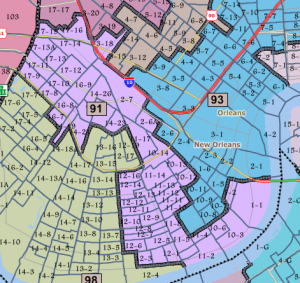Incumbent – Walt Leger III (D – Term Limited in 2019)
District Map
Vote History
|
2008 President |
||
| Current District | New District | |
| John McCain (R) | 2554 (18%) | 2676 (14%) |
| Barack Obama (D) | 11655 (80%) | 16663 (85%) |
| Others | 297 (2%) | 332 (2%) |
|
2008 Senate |
||
| Current District | New District | |
| Mary Landrieu (D) | 11718 (83%) | 16513 (87%) |
| John Kennedy (R) | 2023 (14%) | 2105 (11%) |
| Others | 307 (2%) | 377 (2%) |
|
2010 Senate |
||
| Current District | New District | |
| David Vitter (R) | 1861 (20%) | 1862 (15%) |
| Charlie Melancon (D) | 7074 (75%) | 9844 (80%) |
| Others | 451 (5%) | 615 (5%) |
|
2010 Lt Governor |
||
| Current District | New District | |
| Jay Dardenne (R) | 2338 (25%) | 2453 (20%) |
| Caroline Fayard (D) | 7067 (75%) | 9856 (80%) |
Current District
House District 91 is located in New Orleans and includes a mixture of upper and lower income neighborhoods between the Garden District and Uptown. The district itself is shaped like the letter “C” – its approximate boundaries are Claiborne Avenue in the north, Jefferson Avenue in the west, the Mississippi River in the south, and Felicity Street in the east.
This is a district that has undergone significant demographic changes due to Hurricane Katrina. A decade ago, the district had a 60% black voter registration; today, the district is 49% black. This change is due to a 13% increase in the number of white voters since 2003, while the number of black voters has decreased 26% during that same time period.
Politically, this is still a solidly Democratic district, as you have a formidable bloc of white liberal voters along St. Charles Avenue and in the Garden District. This means that Democrats can count on getting 80% of the vote in most elections.
These demographic changes, however, have shown up in the legislative representation the district has had. From 1976 until her elevation to the state senate in 1988, black Democrat Diana Bajoie was its representative. She was succeeded by another black Democrat, Renee Gill Pratt, who served from 1988 until her 2002 election to the New Orleans City Council. Rep. Pratt’s departure created a special election, with Rosalind Peychaud narrowly defeating Jalila Jefferson-Bullock (the daughter of former Congressman Jefferson) in the runoff with 51%. Jefferson-Bullock, however, reversed that result in the 2003 runoff by defeating Rep. Peychaud with 58% of the vote.
Representative Jefferson-Bullock could have sought re-election to two more terms before term limits applied to her, but she unsuccessfully ran for Diana Bajoie’s term-limited state senate seat in 2007. And it was in this election that the demographic changes after Katrina became apparent. Eight candidates sought the House seat, but the victor, attorney Walt Leger III (who is white) defeated a black challenger in the runoff with 65%. Not only did he get over 80% in the white precincts, he received about 50% of the vote in the black precincts at the northern and southern ends of the district. (UPDATED 9/9/2011) Rep. Leger is allowed to serve two more terms, and was unopposed in 2011.
New District
Redistricting was an unpleasant chore for those representing districts in New Orleans, especially since you had a situation where three formerly black majority districts were represented by white Democrats in the Garden District and Uptown. It also didn’t help that District 91 was 30% under populated. The solution was to eliminate one of the districts (the District 95 seat held by Walker Hines, who switched to the Republican Party). Another district (the District 98 seat held by Neil Abramson) was redrawn to have a white majority, while District 91 regained its black majority status.
The way this was done was as follows: a string of precincts between Jefferson and Napoleon that was 32% black was removed and placed in District 98. Added to the district was a 66% black section of town between Claiborne Avenue and I-10 that both Districts 95 and 98 contributed. These changes increased the black influence in the district from 49 to 62%. (UPDATED 9/9/2011) While Rep. Leger was unopposed in 2011, this reconfiguration of the district means that there is always the possibility that a major black challenger could emerge next time and make electoral mischief for Rep. Leger.


[…] District Map: Continue reading at http://new.winwithjmc.com/archives/3485 […]
Websites You Should Visit…
[…]very few websites that happen to be detailed below, from our point of view are undoubtedly well worth checking out[…]…
Visitor recommendations…
[…]one of our visitors recently recommended the following website[…]……
Links…
[…]Sites of interest we have a link to[…]……
Check this out…
[…] that is the end of this article. Here you’ll find some sites that we think you’ll appreciate, just click the links over[…]……
Recommeneded websites…
[…]Here are some of the sites we recommend for our visitors[…]……
Read was interesting, stay in touch……
[…]please visit the sites we follow, including this one, as it represents our picks from the web[…]……